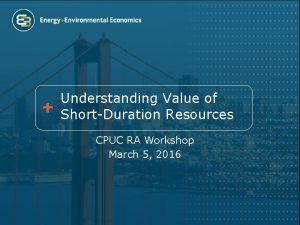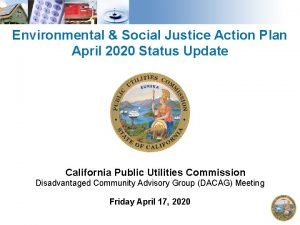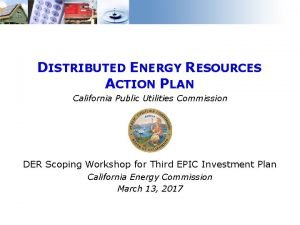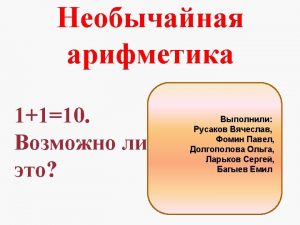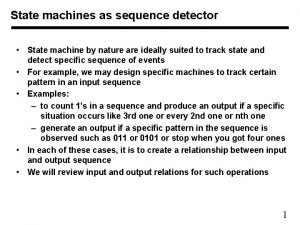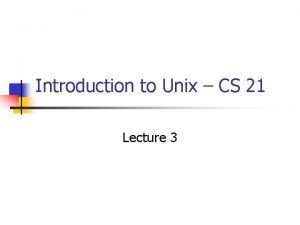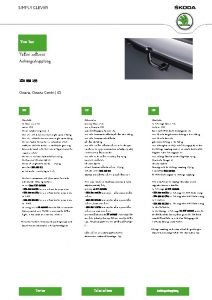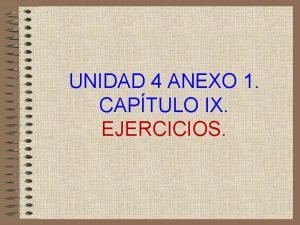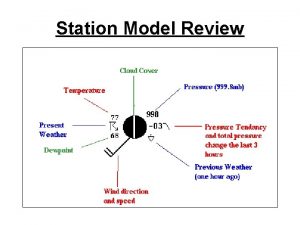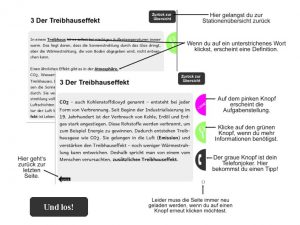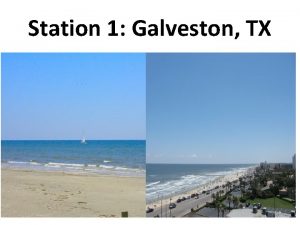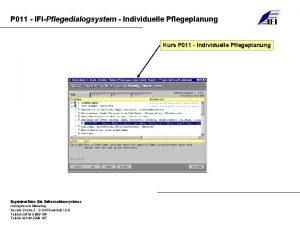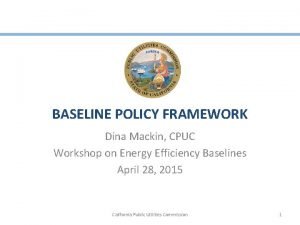CPUC Storage Workshop R 15 03 011 Station

















- Slides: 17

CPUC Storage Workshop (R. 15. 03. 011) – Station Power May 2, 2016 Aloke Gupta Senior Director, Market Development & Policy Aloke. Gupta@imergy. com

Imergy Company Overview • Leading developer of energy storage solutions based on vanadium redox flow battery technology • Scalable solutions: 5 k. W to multi - MW § Low cost, long duration, very long life (no capacity degrade) § Non-flammable, non-explosive § Unlimited cycles, resilient in harsh environment / high temperatures § Proprietary process for utilizing low-grade vanadium from waste • Growing sales in India, Africa, Europe, US § Over 100 units deployed (with over three years field experience) and growing backlog § Microgrids (off / weak grid, military, etc), islands, customer-side, utility applications § High volume production line established with a large contract manufacturer & proven logistics & supply chain • Extensive IP portfolio with over 20 patents © 2016 Imergy Power Systems, Inc.

Energy Consumption at Energy Storage Plant (ESP)* • Efficiency losses • Resistive losses • Self-discharge • Pump (flow battery) • PCS (power conversion system) losses • Transformer losses • Controller (BMS) • Cooling • IT, comms, lighting, ventilation, safety, etc. Types of Consumption 1. Efficiency losses 2. Auxiliary loads 3. End-use loads *Based on Electro-Chemical Battery Technology © 2016 Imergy Power Systems, Inc. 3

ESP* Energy Consumption Categorized • Efficiency losses § § § Resistive Self-discharge Pump (flow battery) PCS Transformer $Wholesale • Non-discretionary (“auxiliary”) loads required with ES unit operation Controller (BMS) § Cooling § … § $? ? • Discretionary (“end-use”) loads not directly related to ES unit operation § IT, comms, lighting, ventilation, safety, etc. *Based on Electro-Chemical Battery Technology © 2016 Imergy Power Systems, Inc. $Retail 4

ES Plant Architecture The Grid Transformer AC – DC PCS DC – DC Battery ES Unit © 2016 Imergy Power Systems, Inc. 5

ES Plant Architecture The Grid Transformer AC – DC PCS DC – DC Battery [pump] Efficiency Losses © 2016 Imergy Power Systems, Inc. ES Unit 6

ES Plant Architecture The Grid Transformer AC – DC PCS DC – DC Cooling BMS Battery [pump] Aux Loads (non-discretionary) © 2016 Imergy Power Systems, Inc. Efficiency Losses ES Unit 7

ES Plant Architecture The Grid Transformer AC – DC meter PCS DC – DC IT Heating Ventilation Etc. Cooling BMS Battery [pump] Aux Loads (non-discretionary) End Use Loads (discretionary) © 2016 Imergy Power Systems, Inc. Efficiency Losses ES Unit 8

ES Plant Architecture The Grid Transformer AC – DC meter PCS DC – DC IT Heating Ventilation Etc. Cooling BMS Battery [pump] Aux Loads (non-discretionary) End Use Loads (discretionary) © 2016 Imergy Power Systems, Inc. Efficiency Losses ES Unit 9

Key Points • Transformer, PCS, Pump losses: are conceptually no different from resistive / self-discharge losses and § should be included in aggregate efficiency loss of ES unit § • Energy “consumption” via ES unit’s efficiency losses is different from energy consumption via ES unit’s auxiliary load • All components of efficiency losses should be treated as wholesale at all times § No rate distinction should be made between efficiency losses while charging / discharging vs. efficiency losses while not charging / discharging © 2016 Imergy Power Systems, Inc. 10

Efficiency Losses vs. Aux Loads Explained • Transformer, PCS, Pump losses conceptually no different from resistive / self-discharge losses (all should be included in aggregate efficiency loss) § Unintended loss: inherent, unavoidable, byproduct, occurs at all times (cannot ever be “turned off” while energy storage unit in operation) § Provides no useful function (thus not a load or end use) § Cannot be metered separately from charge / discharge energy § From grid/market perspective, not meaningful to distinguish from underlying battery • ESU’s “aux loads” different from “efficiency losses” § Intended energy consumption (could be turned off short-term) § Provide useful functions that enable ESU operations § Could be metered separately, but not clear if necessary § Are essential to ES unit operations § Utilized directly (and only) in “furtherance of a wholesale transaction” © 2016 Imergy Power Systems, Inc. 11

Generic Commodity Trading Purchase (to resell) 100 u Sell (to repurchase) 95 u • Purchase with intent to resell ~ wholesale § Although some portion is lost permanently • Sell with intent to repurchase ~ wholesale Lost 5 u Day 1 Day 2 © 2016 Imergy Power Systems, Inc. 12

Efficiency Losses ~ Wholesale Purchase (charge) 100 u Sell (discharge) 95 u Lost 5 u Day 1 Day 2 • Efficiency losses during charge / discharge should be treated as wholesale § All of 100 u (electrical energy) purchased with intent to resell (wholesale), even though some portion expected to be lost permanently • SCE’s recommendation* differs slightly … § Retail rates should apply to “end use load” typically comprised of inverter / transformer loads when storage unit is not charging / discharging § Above “baseline end-use load” applies in all hours regardless of operation • Counter: Baseline losses in inverter / transformer… § Similar to baseline losses in T or D grid § Arbitrary distinction from the baseline losses in underlying battery (presumably still wholesale)…could introduce arbitrary economic distortions § Not really “end use load” – no useful function § Appears not consistent with current concept of station load (per CAISO SPP): Ø “Energy for operating electric equipment … used exclusively for the production of Energy … by the Generating Unit” Ø “Energy for operating electric equipment … used exclusively for the charging (absorbing) / discharging / storing Energy … by the Energy Storage Unit *SCE’s Opening Comments, p. 18. © 2016 Imergy Power Systems, Inc. 13

“Standby” Consumption at Which Rate? “Standby Period” Purchase (charge) 95 u Day 1 Purchase 1 u Purchase 1 u Lost 1 u Lost 1 u Day 2 Day 3 Day 4 Day 5 Day 6 Sell (discharge) 95 u Day 7 SDG&E / LS Power recommendation* (paraphrase): • Energy withdrawn from grid when ES unit is neither charging / discharging (= “standby”) is end-use (station) load subject to retail rates • Thus, 5 u (Day 2 – 6) charged at retail • If this recommendation applies to… § (discretionary) end-use loads: § (non-discretionary) aux loads: § efficiency losses: © 2016 Imergy Power Systems, Inc. agree no comment counter *SDG&E’s Opening Comments, p. 8, LS Power’s Opening Comments, p. 3. 14

“Standby” Efficiency Losses (Purchases) ~ Wholesale Purchase (charge) 95 u Purchase 1 u Day 1 Purchase 1 u Lost 1 u Lost 1 u Day 2 Day 3 Day 4 Day 5 Day 6 Sell (discharge) 95 u Day 7 • All of 100 u purchased with intent to resell (thus, wholesale), even Purchase (charge) 100 u Sell (discharge) 95 u • To do otherwise (i. e. treat 5 u as retail) leads to issues: § Administratively problematic (how to determine when ES unit is not charging / discharging) § Introduces arbitrary economic distortions between different scenarios of wholesale Lost 5 u Day 1 though some portion expected to be lost permanently transactions Day 2 § Lacks justification as there is no extra/different burden (associated with 1 u x 5) on UDC § No clear policy benefit for the arbitrariness, added complexity, & distortions • Conclusion… © 2016 Imergy Power Systems, Inc. All components of efficiency losses (as defined here) at all times ~ wholesale 15

Summary 1. What rules or guidelines are needed…? § § § Proposed three categories of energy consumption associated with Energy Storage Plant Efficiency losses include transformer, PCS, pump, self-discharge, resistive… Several guidelines (tests) proposed to distinguish “efficiency losses” from “aux loads” (nondiscretionary) and “end-use loads” (discretionary) All components of efficiency losses (as defined here) at all times treated as wholesale TBD: treatment of aux loads (as defined here) 2. Are there any rules/guidelines required outside of … CAISO? § See above 3. What are rate implications for station power in the context of ES? § Discretionary end-use loads classified as station power with no difference in rate implications vs. status quo (i. e. still subject to retail rates) © 2016 Imergy Power Systems, Inc. 16

Thank you Aloke Gupta Senior Director, Market Development & Policy Aloke. Gupta@imergy. com 17
 Cpuc elcc
Cpuc elcc Cpuc esj action plan
Cpuc esj action plan Cpuc der action plan
Cpuc der action plan Fd p 18-011
Fd p 18-011 00 000 011 10 11 1000 11
00 000 011 10 11 1000 11 1 10 11 100 101 110 111 1000 1001 1010
1 10 11 100 101 110 111 1000 1001 1010 011 sequence detector
011 sequence detector Etsi gs nfv-ifa 011
Etsi gs nfv-ifa 011 Global trade repository
Global trade repository Ggg-p2-011
Ggg-p2-011 Sol001
Sol001 Nem 011
Nem 011 Umask 011
Umask 011 Eea 600 011
Eea 600 011 Let 011 unidad iv ejercicios
Let 011 unidad iv ejercicios 100 011
100 011 Rmer-011
Rmer-011 Primary storage and secondary storage
Primary storage and secondary storage
